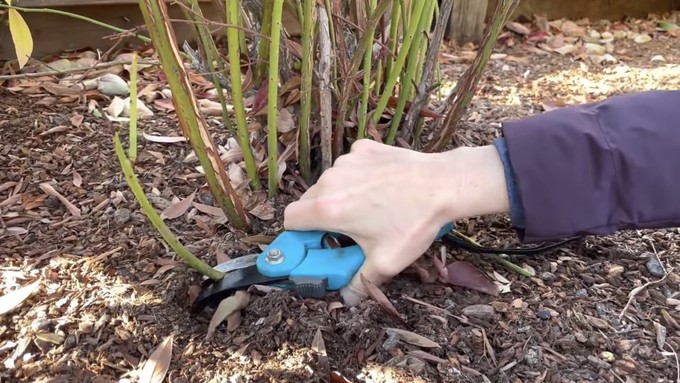
Planning, planting classes and videos offered by the area's master gardeners

Sacramento County master gardener Tamara Engel demonstrates how to prune a mature blueberry plant in a YouTube video. Screenshot from Sacramento County master gardeners' YouTube channel
We’re back to rain today (and likely Sunday) but even with wet conditions gardeners can still make progress the next several days toward their spring gardens. Choosing and starting seeds, for example, planning irrigation, or learning how to maximize planting spaces will all contribute to success.
The region’s master gardeners have three classes coming up that can help in those pursuits:
– “Gardening in Small Spaces,” 9 a.m. to noon, Wednesday, Feb. 8. This three-hour in-person class from the El Dorado County master gardeners will be held at the Cameron Park Community Center, 2502 Country Club Drive, Cameron Park. Master gardener Mike Pavlick will cover site location, design, raised bed options, container gardening and other methods that will allow anyone to have a vegetable garden in a small backyard setting. No pre-registration required. Information on the El Dorado master gardeners' events can be found here.
– “Growing Spring and Summer Vegetables,” Zoom online class, 9 a.m. to noon, Saturday, Feb. 11. El Dorado master gardener Zack Dowell will discuss garden plant selection, planting times, site selection, soil preparation, proper seed planting techniques, and pest management. Pre-registration is required to get the Zoom link. The registration link can be found under the class listing here: https://mgeldorado.ucanr.edu/Calendar/
– “Improving Water Efficiency in Your Garden,” in-person and Zoom workshop, 10:30-11:30 a.m. Saturday, Feb. 11. Presented by the Placer County master gardeners, it will include tips and resources for maximizing their water efficiency. Participants will gain water-wise ideas and visuals for transforming their landscape, organizers note. The in-person site is the Loomis Library, 6050 Library Drive, Loomis. The registration link for the simultaneous Zoom workshop can be found here.
Meanwhile, the Sacramento County master gardeners recently posted two helpful YouTube videos for this time of year: “Pruning Mature Blueberry Plants,” with master gardener Tamara Engel, and “Transplanting Nursery Plants for a Healthy Start” with master gardener Lisa Odom. Each is just 5 minutes, succinct and easy to repeat.
– Kathy Morrison
Comments
0 comments have been posted.Sacramento Digs Gardening to your inbox.
Food in My Back Yard Series
May 6: Maintain soil moisture with mulch for garden success
April 29: What's (already) wrong with my tomato plants?
April 22: Should you stock up on fertilizer? (Yes!)
April 15: Grow culinary herbs in containers
April 8: When to plant summer vegetables
April 1: Don't be fooled by these garden myths
March 25: Fertilizer tips: How to 'feed' your vegetables for healthy growth
March 18: Time to give vegetable seedlings some more space
March 11: Ways to win the fight against weeds
March 4: Potatoes from the garden
Feb. 25: Plant a fruit tree now -- for later
Feb. 18: How to squeeze more food into less space
Feb. 11: When to plant? Consider staggering your transplants
Feb. 4: Starting in seed starting
Sites We Like
Garden Checklist for week of May 11
Make the most of the lower temperatures early in the week. We’ll be back in the 80s by Thursday.
* Plant, plant, plant! It’s prime planting season in the Sacramento area. Time to set out those tomato transplants along with peppers and eggplants. Pinch off any flowers on new transplants to make them concentrate on establishing roots instead of setting premature fruit.
* Direct-seed melons, cucumbers, summer squash, corn, radishes, pumpkins and annual herbs such as basil.
* Harvest cabbage, lettuce, peas and green onions.
* In the flower garden, direct-seed sunflowers, cosmos, salvia, zinnias, marigolds, celosia and asters. (You also can transplant seedlings for many of the same flowers.)
* Plant dahlia tubers.
* Transplant petunias, marigolds and perennial flowers such as astilbe, columbine, coneflowers, coreopsis, dahlias, rudbeckia and verbena.
* Keep an eye out for slugs, snails, earwigs and aphids that want to dine on tender new growth.
* Feed summer bloomers with a balanced fertilizer.
* For continued bloom, cut off spent flowers on roses as well as other flowering plants.
* Add mulch to the garden to maintain moisture. Mulch also cuts down on weeds. But don’t let it mound around the stems or trunks of trees or shrubs. Leave about a 6-inch-to-1-foot circle to avoid crown rot or other problems.
* Remember to weed! Pull those nasties before they set seed.
* Water early in the day and keep seedlings evenly moist.